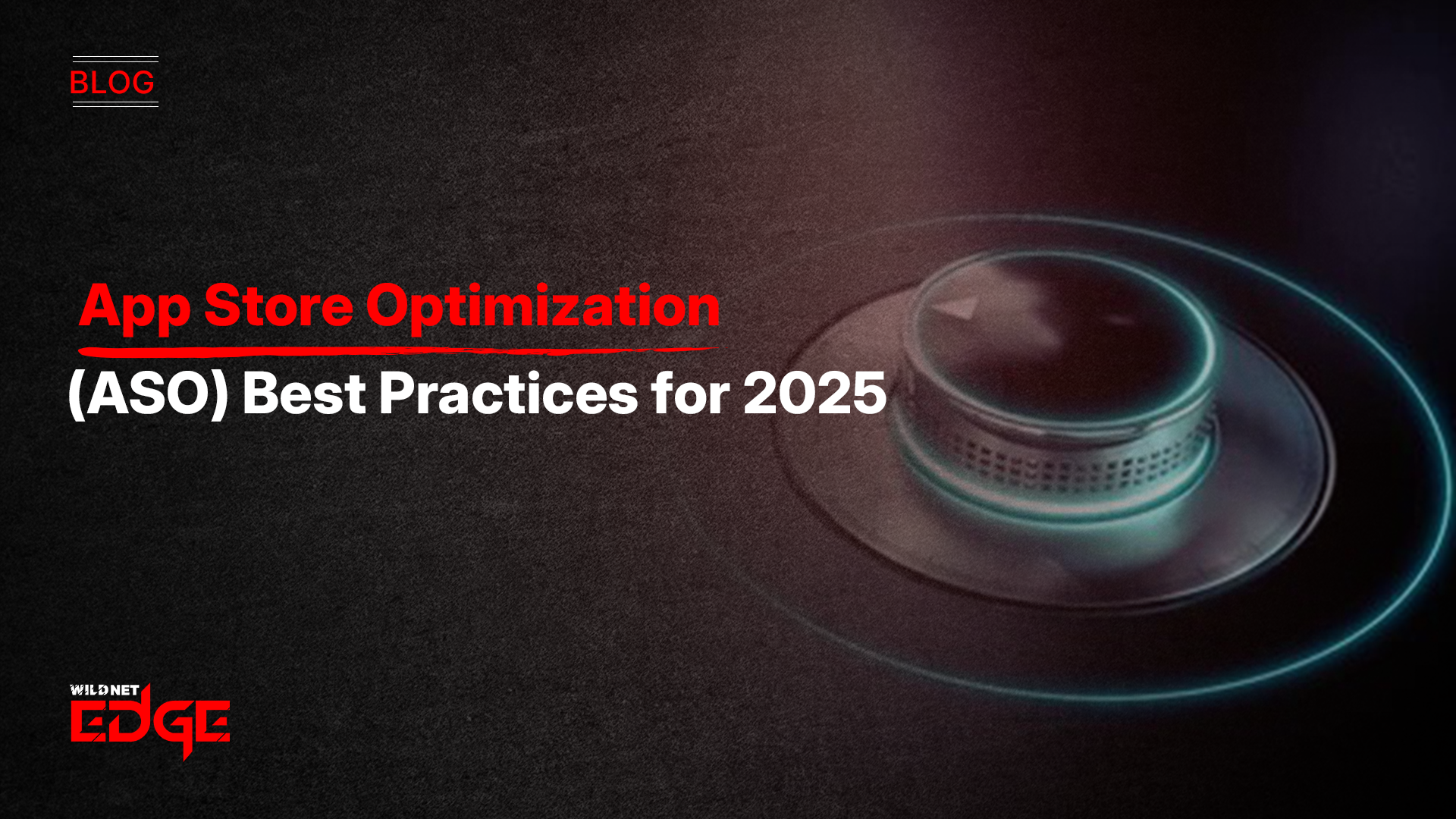With millions of mobile apps in the market, App Store Optimization (ASO) has become the central pillar of an app’s success rather than just a choice. It is also known as “SEO for the app stores,” ASO is the permanent activity of increasing the visibility and conversion rate of your app within the Apple App Store and Google Play Store in order to generate more organic downloads.
A well-planned App Store Optimization campaign lowers the acquisition cost of users by drawing in high-quality, free-of-cost traffic and establishing credibility right away. There are ultimate three aims of ASO: Keyword optimization, Conversion optimization, and Discoverability.
Types of App Store Optimization
The process of ASO is broad, but it can be broken down into two main categories based on where the optimization takes place.
Manual App Store Optimization – The Foundational Elements
This part focuses on making the app’s listing page visually attractive to the app store and potential users by improving its textual and visual elements. To be specific, it is composed of the app name, subtitle, descriptions, keywords, icons, and screenshots. It is the first basic step in making sure your app is recognized properly by the app store algorithms and can attract a potential user. The emphasis on manual app store optimization should be the starting point where you will invest most of your efforts.
Advanced App Store Optimization – Performance and Strategy
This is the application of data-driven and continuous efforts for your ranking indirectly. To be more precise, it includes A/B testing, controlling ratings and reviews, increasing app retention and minimizing uninstall rates, and using Custom Product Pages. The app store can evaluate your app’s quality and authority based on these elements, which are at the core of advanced app store optimization, and these elements are the main signals that the app store algorithms use.
App Store Optimization Best Practices – Key Components
To get the top search results and to convert users, the core components of your app listing must be mastered.
Metadata Optimization – Targeting Search
Keyword Research: Find high-volume keywords. Then, by analyzing competitors, find the gaps by starting with a seed keyword list.
- Strategic Placement: App Name/Title (maximum 30 characters) should contain the strongest keyword. Use the subtitle (Apple) or short description (Google) for your next most important terms.
- Platform Differences: Use the 100-character keyword field effectively on the Apple App Store and avoid overlap. On Google Play, repeat keywords in the long description in such a way that you achieve a target density of about 2-3%.
Creative Optimization – Driving Conversion
- App Icon: It should be attractive and of high quality, and it should depict your app’s function instantly.
- Screenshots: These are the second-best factor after ratings in converting users. Use all the slots to showcase the app’s benefits and major features with text.
- App Preview Video: This is the 30-second video showing how the in-app experience can boost conversion rates significantly.
App Store Optimization Trends & Advanced Strategy
Marketing people are required to evolve with the latest features and data because the mobile world is changing continuously.
Localization and Custom Pages
Localization means modifying the metadata and images to suit regional, cultural, and linguistic settings. The adoption of Custom Product Pages for the Apple store and Custom Store Listings for Google Play is undoubtedly one of the major trends in mobile app store optimization. These functionalities allow you to effortlessly create multiple variations of your app store page that are tailored to particular ad campaigns or targeted user groups, thereby increasing the relevance and conversion rate of your paid traffic to the max.
Reputation and Engagement
The ranking algorithms of the app stores give a strong preference to the apps with high authority, which is indicated by:
- Ratings and Reviews: Getting at least 4.0 for the average rating is usually the minimum requirement to be on the featured list. Happy users should be tactically persuaded to write reviews. It is a good show of management to respond to all reviews (positive as well as negative).
- Retention and Uninstall Rate: Google’s algorithm is one of those that pay attention to how frequently users uninstall your app or how well they are kept. This brings to the fore the necessity for a satisfactory user experience (UX) within the app.
Why Businesses Need Custom ASO Services
- Tailored Strategies for Unique Needs: Every application and company has its own characteristics. Custom ASO services include thorough market research and competitor analysis to come up with a plan that matches the company’s specific objectives, target demographic, and market difficulties.
- Keyword optimization to target your audience: General App Store Optimization (ASO) services often employ a generic set of high competitor keywords, as opposed to custom ASO services, which conduct research to identify a combination of high-volume and low competition longtail keywords that your target audience is likely to be using, ultimately increasing chances at higher rankings in related search results and qualified users.
- Better conversions: The customization of your custom ASO service includes optimization of any marketing components (icons, screenshots, videos) and descriptions to appeal to your user base. The more customized design process typically includes A/B testing as well, which means that the app is going to be downloaded more often by the users accessing it, since they are going to find it. Overall, time, research into your competitors, and a focus on your audience are going to provide a substantial increase in conversion rates.
- Competitive Advantage: The app market is very crowded as there are millions of apps to choose from. A unique ASO strategy will not only help an app to stand out but also provide it with a sustained market advantage by the effective use of unique selling points and discovering weaknesses in competitor strategies.
- Cost-Effectiveness and Better ROI: Custom ASO, which is mainly aimed at acquiring organic, high-intent users, can greatly lessen the reliance on costly paid advertising campaigns and thus result in a lower user acquisition cost.
At WildnetEdge, we offer comprehensive App Store Optimization services, ensuring your app is not just found, but chosen, maximizing your organic downloads and user quality.
Decoding the Algorithm: ASO for Apple vs. Google Play
While the principles of ASO are the same, the two app stores have distinct ranking algorithms. Mastering these differences is critical for a truly successful strategy.
| Feature | Apple App Store (iOS) | Google Play Store (Android) |
| Keyword Relevancy | Metadata-driven (Title, Subtitle, 100-char Keyword Field). | Expanded scope (Title, Short/Long Description, In-app text). Google uses machine learning (semantic understanding). |
| Keyword Strategy | No repetition needed. A keyword only needs to appear once to be indexed. | Keyword Density (approx. 2-3%) in the Long Description is a factor. |
| Key Ranking Strength | Download Velocity, Conversion Rate, Ratings, Reviews, and In-App Events. | Download Velocity, Ratings, Reviews, Retention Rate, Uninstall Rate, Android Vitals (performance). |
| Updates | Regular updates signal active maintenance and may boost visibility. | Frequent updates and high-quality app performance are strong ranking signals. |
Case Studies
Global Beauty Shopping Apps
This case study highlights how a major beauty retailer’s app, featuring top brands like FENTY BEAUTY and The Ordinary, significantly boosted its revenue through targeted App Store Optimization (ASO) services.
Problem
The app’s user base needed to grow in a competitive market that is very tough. The marketing plan was divided into segments:
- Initial Goal: To raise the app’s visibility and presence in the search results in the app store in a general way.
- Secondary Goal: To increase the CR to the extent that the new traffic becomes downloads and revenue.
Solution
The ASO services team planned and executed a two-step process using data at every stage:
- Data-Informed Keyword Targeting: To carry out full-fledged research, a proprietary ASO platform was employed and it identified high-value keyword themes associated with the app’s popular features such as skincare routines and best-selling products.
- Holistic Optimization: The plan included researching
- Market Trends and seasonality in the app industry.
- Competitor’s keyword strategy and positioning.
- Creative assets (screenshots, icons) and listing messaging were tested using a strategic A/B approach to maximize the conversion funnel.
Impact
The application of the data-driven ASO strategy resulted in the entire range of performance benefits:
- Massive Conversion Rate Increase: The optimization activities resulted in a big rise in the download Conversion Rate, which is the proportion of visitors who tried the app and then downloaded it.
- Cross-Channel Revenue Growth: The increased CR also led to better performance across all marketing channels (organic search, paid ads, referrals), and thus increased the overall revenue of the company.
Educational Book Summary App
This case study showcases how the stringent App Store Optimization (ASO) process supported the mobile application, “StoryShots,” which offers book summaries in different formats (text, audio, video), to attain tremendous growth without any marketing expense.
Problem
One of the educational app’s primary difficulties was the need to “pay” the authors it endorsed by making them “visible” through organic downloads in bulk. The client pointed out that ASO was the most cost-effective solution for driving native app traffic, as he did not have a marketing budget to dedicate to the purpose.
Solution
The AOS services team applied an AOS Intelligence tool and a data-driven approach, concentrating on awakening visibility in multiple regions:
- Market-Specific Keyword Research: The tool was utilized to identify high-traffic keywords that were already drawing search volume in different international markets.
- Title Optimization: App’s titling underwent a modification that was involved in direct incorporation of powerful keywords, hence, influencing the search rankings.
- Localization: The app listing was made suitable for 30 new markets and ensured that their metadata and keywords were blended into the titles in a culturally and linguistically appropriate manner for the worldwide potential users.
Impact
- The strategic ASO produced huge growth that was effective in terms of cost:
- Massive User Acquisition: The application managed to attract tens of thousands of new organic users in just a couple of months.
- Cost-Effective Growth: ASO was pivotal in reaching high download numbers without depending on a paid marketing budget and thus solved the client’s primary problem effectively.
- Global Reach: The widespread localization efforts brought quick recognition in 30 new markets, which in turn, enlarged the app’s global presence.
Conclusion
Thus, to become visible in the mobile world and to attract more users to the app is a continuous process that requires hard work, attention to detail, and a well-thought-out plan. The best App Store Optimization (ASO) practices for 2025 are mainly about performing keyword research in a targeted way, creating good visual content, making the best use of localized content, and accepting the emerging trends such as voice search and AI-based tools. If you use these techniques, your app will be discovered and gain visibility into loyal customers.
WildnetEdge is your top partner for trustworthy and professional App Store Optimization solutions assistance. Their research methods and practical knowledge allow marketers to stay one step ahead in the constantly evolving app market.
Are you ready to take your app’s performance to the next level? Then, the partnership with WildnetEdge is the way to go!
FAQs
Q1: Does the number of downloads directly impact ASO?
Absolutely. Download velocity (number of downloads counted over a short period) is a common factor in the ranking for both app stores, which indicates the popularity of your app and its authority to the algorithm.
Q2: What are Custom Product Pages (CPPs)?
Custom Product Pages (CPPs), which are the term for Apple and Customized Store Listings for Google, are your app’s different versions of the listing page that are used to attract certain groups of people or ad campaigns with matching creative aspects and metadata, thus considerably increasing conversion rates.
Q3: Is ASO really “free” marketing?
ASO gets organic (unpaid) downloads. Even though the labor and tools needed for ASO are not free, the downloads resulting from a good organic ranking are one of the cheapest ways to acquire users compared to running paid ads.
Q4: What are the best visual elements for the A/B test first?
The app icon and the first two screenshots are the most influential factors in a user’s decision to download an app or not. For the quickest wins in conversion rate, you should start your A/B testing there.
Q5: How long does it take to see ASO results?
You will probably notice some ranking changes in a few days after you update the metadata. Nevertheless, the big, stable increase in organic do.

Nitin Agarwal is a veteran in custom software development. He is fascinated by how software can turn ideas into real-world solutions. With extensive experience designing scalable and efficient systems, he focuses on creating software that delivers tangible results. Nitin enjoys exploring emerging technologies, taking on challenging projects, and mentoring teams to bring ideas to life. He believes that good software is not just about code; it’s about understanding problems and creating value for users. For him, great software combines thoughtful design, clever engineering, and a clear understanding of the problems it’s meant to solve.
 sales@wildnetedge.com
sales@wildnetedge.com +1 (212) 901 8616
+1 (212) 901 8616 +1 (437) 225-7733
+1 (437) 225-7733































